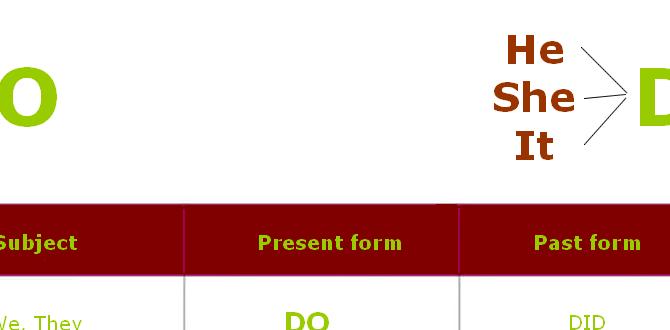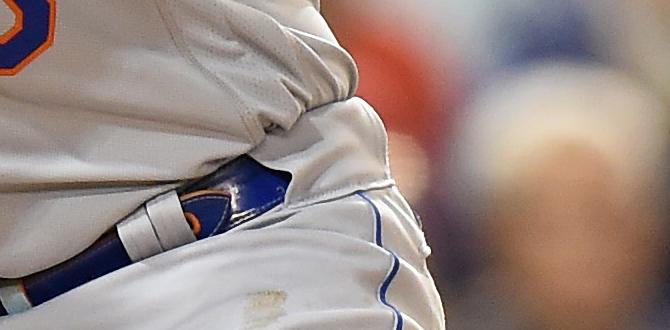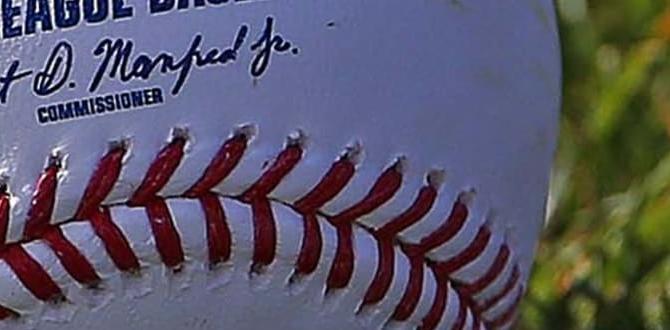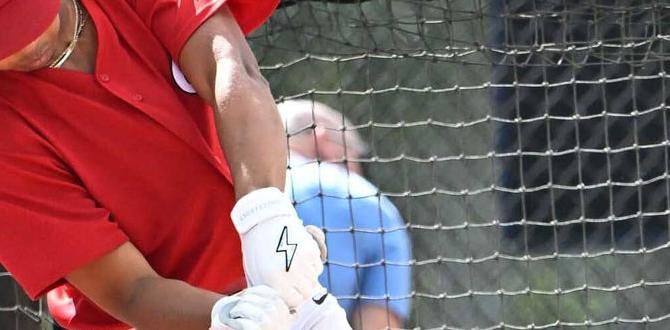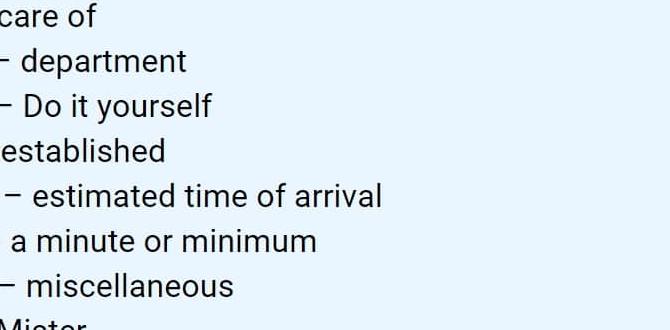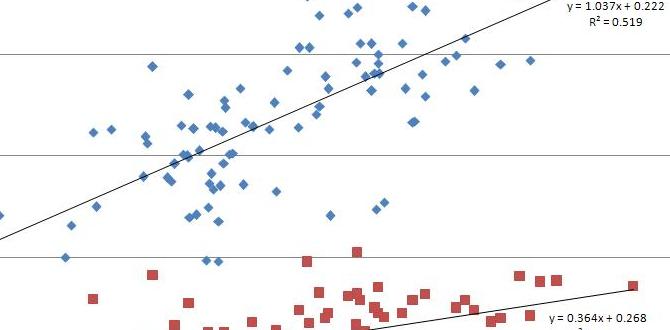Have you ever watched a baseball game and heard the term “OPS”? What does it mean? OPS stands for On-base Plus Slugging. It’s a cool way to measure how well a player does at hitting and getting on base.
Imagine your favorite player swinging the bat. They hit the ball, reach base, and run like the wind. Every time they get on base or hit a home run, it counts towards their OPS. That’s exciting, right?
OPS helps fans understand who the best players are. It combines two important skills: reaching base and hitting for power. This simple number can tell you a lot about a player’s talent.
If you’re curious about how OPS works and why it matters, keep reading. You might be surprised at how much more fun baseball can be when you understand it better!
What Is Ops In Baseball Stand For And Its Importance?
What Does OPS in Baseball Stand For?
OPS is a key baseball term that stands for On-base Plus Slugging. This stat combines a player’s on-base percentage (how often they reach base) and slugging percentage (how many bases they earn per hit). It helps fans see a player’s overall hitting ability. Did you know? Great players often have high OPS scores! This number shows how effective a batter is in contributing to their team’s success. Understanding OPS can make watching the game even more exciting!Definition of OPS
Explanation of the acronym OPS (OnBase Plus Slugging). Importance of OPS in baseball statistics.OPS stands for On-Base Plus Slugging. This statistic combines two important skills: getting on base and hitting for power. It adds a player’s on-base percentage to their slugging percentage, giving a clear picture of their overall performance. OPS is crucial in baseball because it helps evaluate how well a player contributes to scoring runs.
- On-Base Percentage: Measures how often a player gets on base.
- Slugging Percentage: Reflects the power of a player’s hits.
Many fans and coaches use OPS to compare players. A higher OPS means a player is better at helping their team win!
What does OPS mean in baseball?
OPS means On-Base Plus Slugging. It measures how well a player gets on base and hits for power.
How OPS is Calculated
Breakdown of the components: OnBase Percentage (OBP) and Slugging Percentage (SLG). Formula for calculating OPS.To understand how OPS works, we need to look at two big parts: On-Base Percentage (OBP) and Slugging Percentage (SLG). The formula for OPS is simple: OPS = OBP + SLG.
- On-Base Percentage (OBP) shows how often players reach base. It includes hits, walks, and errors.
- Slugging Percentage (SLG) measures a player’s power. It counts total bases divided by at-bats.
This combination gives us a clear score to see how well a player performs overall. A high OPS means a player is doing great!
Importance of OPS in Evaluating Player Performance
Comparison with traditional batting statistics (e.g., batting average, home runs). Why OPS provides a more comprehensive view of a player’s offensive capabilities.OPS is like the Swiss army knife of baseball stats! It combines two key parts of a player’s hitting: on-base percentage and slugging percentage. Traditional stats like batting average or home runs don’t tell the whole story. OPS gives a better picture of how well a player can get on base and hit for power. Think of it as adding some spice to a plain dish. You want to enjoy all the flavors!
| Statistic | Meaning |
|---|---|
| Batting Average | Hits divided by at-bats |
| Home Runs | Count of round-trippers |
| OPS | Combines chances of getting on base and hitting for power |
By looking at OPS, teams see the complete offensive picture. Sure, a player might have lots of home runs, but what about their ability to get walks? OPS helps spot hidden gems who contribute a lot more than just round-trippers!
Historical Context of OPS
Emergence of OPS as a key statistical measure. Impact of OPS on player evaluation and team strategy over the years.OPS, which stands for On-base Plus Slugging, emerged as a pivotal statistic in baseball during the late 20th century. It combines two essential skills: reaching base and hitting for power. This made OPS a modern hero in player evaluation. Teams now glance at OPS to spot sluggers and savvy base runners, almost like searching for gold in a treasure chest. Over the years, it changed how teams strategize, with many saying, “Why just get on base when you can blast it too?”
| Year | OPS Impact |
|---|---|
| 2000 | Teams focused more on power hitters, increasing runs scored. |
| 2010 | OPS became essential for player trades and drafts. |
| 2020 | Analyzed for pitching matchups, helping teams make tactical decisions. |
OPS Leaders in Major League Baseball
Profiles of current and historical players with high OPS stats. Discussion of players who have changed the game with their OPS metrics.In baseball, some players really know how to hit! They shine in OPS, which is short for On-base Plus Slugging. Players like Babe Ruth and Ted Williams changed the game with their amazing stats. Ruth, always swinging for the fences, had a staggering OPS of .348. Fast forward to today, and Mike Trout is catching eyes with his OPS of around .999. Why? He gets on base and hits for power. It’s like having two superpowers at once! Let’s take a peek at the leaders in OPS:
| Player | Year | OPS |
|---|---|---|
| Babe Ruth | 1920 | .848 |
| Ted Williams | 1941 | .343 |
| Barry Bonds | 2001 | 1.422 |
| Mike Trout | 2022 | .999 |
OPS vs. Other Advanced Metrics
Comparison of OPS with metrics like wOBA and WAR. When to use OPS versus other statistics in analyses.OPS is a great way to measure a player’s hitting abilities. However, it isn’t the only method. wOBA (weighted On-Base Average) provides a more advanced look by weighing different types of hits. Meanwhile, WAR (Wins Above Replacement) estimates how many wins a player adds to their team. Use OPS for quick updates, but for deeper insights, consider wOBA and WAR. Understanding these stats helps fans appreciate the game more deeply.
How does OPS compare to wOBA and WAR?
OPS is simpler but provides less detail than wOBA and WAR. wOBA considers the value of each hit. WAR takes into account defense and position too. For a full view of a player, look at all three stats.
When to use each metric:
- Use OPS for basic hitting analysis.
- Use wOBA for a more accurate player evaluation.
- Use WAR to understand a player’s overall value to their team.
Common Misconceptions about OPS
Clarification of misunderstandings surrounding the statistic. Discussing limitations and contexts where OPS may not tell the full story.Many people think OPS is the be-all and end-all of baseball stats, but that’s a little like saying ice cream is the only dessert. Sure, OPS gives a good glimpse of a player’s hitting, combining on-base percentage and slugging percentage. However, it doesn’t show everything. For example, it ignores defensive skills and clutch moments. So before you bet on OPS like it’s the MVP, remember it has wiggle room! Here’s a simple table to break it down:
| OPS | What It Measures | Limitations |
|---|---|---|
| High OPS | Solid overall hitting | Ignores defense and context |
| Low OPS | Poor hitting performance | May not reflect clutch situations |
In short, OPS is helpful, but not the whole picture. It’s like using a map; it’s great, but you might miss a few fun detours!
How Fans Can Use OPS in Fantasy Baseball
Importance of OPS in fantasy baseball strategies. Tips for assessing player value based on OPS in drafts and trades.Understanding OPS helps fans make smart choices in fantasy baseball. It shows how well a player hits and gets on base. You can assess players better during drafts and trades using OPS. Here are some tips:
- Look for players with a high OPS. They bring more value to your team.
- Consider OPS averages when comparing players. This helps you spot hidden gems.
- Use OPS to analyze players’ consistency. Steady performers are great picks.
Strategies like these can boost your chances of winning!
Why is OPS important in managing a fantasy baseball team?
The OPS number gives a quick view of a player’s hitting skills. It helps fantasy managers pick the best players to score lots of points.
Conclusion
In baseball, “OPS” stands for On-base Plus Slugging. It combines how often players get on base and how many bases they hit. This helps us understand a player’s overall performance. You can use OPS to compare different players. Next time you watch a game, pay attention to OPS stats to see how players are doing! Happy watching!FAQs
What Does The Acronym Ops Stand For In Baseball Statistics?OPS stands for On-base Plus Slugging. It is a way to measure how good a baseball player is at hitting. We add two things together: how often a player gets on base and how many total bases they get from hits. A higher OPS means the player is doing really well.
How Is Ops Calculated, And What Components Are Included In Its Formula?OPS stands for On-base plus Slugging. We calculate OPS by adding two things together: on-base percentage (OBP) and slugging percentage (SLG). On-base percentage shows how often a player gets on base. Slugging percentage shows how many total bases a player gets from hits. So, OPS gives us a number that shows how good a player is at hitting and getting on base.
Why Is Ops Considered An Important Metric For Evaluating A Player’S Offensive Performance?OPS stands for On-base Plus Slugging. It is important because it shows how good a player is at hitting. OPS combines two things: getting on base and hitting for power. When you have a higher OPS, it means you help your team score more runs. That’s why we like to look at it when we judge a player’s performance.
How Does Ops Compare To Other Offensive Metrics Like Batting Average And On-Base Percentage?OPS stands for On-base Plus Slugging. It combines two things: how often a player gets on base and how many bases they hit. Batting average only looks at hits divided by at-bats. On-base percentage shows how often a player gets on base. OPS gives us a bigger picture of how good a player is because it includes both getting on base and hitting for power.
Can Ops Be Used To Compare Players Across Different Eras In Baseball, And If So, How?Yes, we can use OPS, which stands for On-base Plus Slugging, to compare baseball players from different times. OPS tells us how good a player is at getting on base and hitting the ball hard. To compare players from different eras, we can look at their OPS numbers and see who is better. This helps us understand how players performed, even when the game changed over the years. Plus, it gives us a fair way to see their skills side by side.
{“@context”:”https://schema.org”,”@type”: “FAQPage”,”mainEntity”:[{“@type”: “Question”,”name”: “What Does The Acronym Ops Stand For In Baseball Statistics? “,”acceptedAnswer”: {“@type”: “Answer”,”text”: “OPS stands for On-base Plus Slugging. It is a way to measure how good a baseball player is at hitting. We add two things together: how often a player gets on base and how many total bases they get from hits. A higher OPS means the player is doing really well.”}},{“@type”: “Question”,”name”: “How Is Ops Calculated, And What Components Are Included In Its Formula? “,”acceptedAnswer”: {“@type”: “Answer”,”text”: “OPS stands for On-base plus Slugging. We calculate OPS by adding two things together: on-base percentage (OBP) and slugging percentage (SLG). On-base percentage shows how often a player gets on base. Slugging percentage shows how many total bases a player gets from hits. So, OPS gives us a number that shows how good a player is at hitting and getting on base.”}},{“@type”: “Question”,”name”: “Why Is Ops Considered An Important Metric For Evaluating A Player’S Offensive Performance? “,”acceptedAnswer”: {“@type”: “Answer”,”text”: “OPS stands for On-base Plus Slugging. It is important because it shows how good a player is at hitting. OPS combines two things: getting on base and hitting for power. When you have a higher OPS, it means you help your team score more runs. That’s why we like to look at it when we judge a player’s performance.”}},{“@type”: “Question”,”name”: “How Does Ops Compare To Other Offensive Metrics Like Batting Average And On-Base Percentage? “,”acceptedAnswer”: {“@type”: “Answer”,”text”: “OPS stands for On-base Plus Slugging. It combines two things: how often a player gets on base and how many bases they hit. Batting average only looks at hits divided by at-bats. On-base percentage shows how often a player gets on base. OPS gives us a bigger picture of how good a player is because it includes both getting on base and hitting for power.”}},{“@type”: “Question”,”name”: “Can Ops Be Used To Compare Players Across Different Eras In Baseball, And If So, How? “,”acceptedAnswer”: {“@type”: “Answer”,”text”: “Yes, we can use OPS, which stands for On-base Plus Slugging, to compare baseball players from different times. OPS tells us how good a player is at getting on base and hitting the ball hard. To compare players from different eras, we can look at their OPS numbers and see who is better. This helps us understand how players performed, even when the game changed over the years. Plus, it gives us a fair way to see their skills side by side.”}}]}
